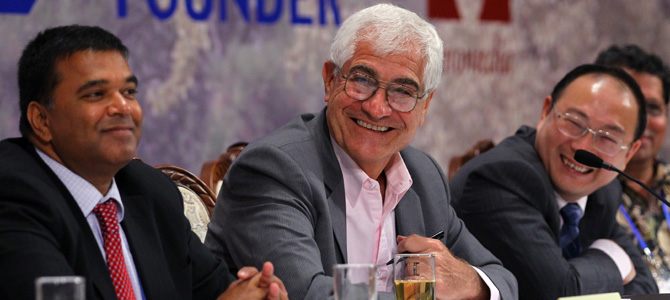
BEIJING - The amount of photovoltaic capacity installed in China will reach 21 gigawatts by 2015, four times more than that in the government's initial plan, local media reported citing sources from the National Energy Administration.
Although the figure has yet to be confirmed, there is no doubt that the country is pouring investment into the new energy sector, especially the renewable energy resources.
The government is trying to combine stimulus measures and restructuring efforts to reinvigorate the slowing economy.
On the website of the National Development and Reform Commission (NDRC), there are lists of all projects approved by the country's top economic planner. By June 20, a total of 1,500 projects had been approved, the data shows.
Among the approved projects, new energy ones such as wind power and photovoltaic power generation account for a big proportion. Others include information engineering, high-end equipment, technical innovation, water conservation and poverty-relief projects.
Energy saving and environmental protection are notably emphasized in new projects. For example, in the power sector, projects with big generating capacities are replacing those with small capacities. Similar changes are happening in the metallurgy and building materials industries.
Since the financial turmoil, the weaknesses of the Chinese economy -- its excessive dependence on external demand -- have been exposed. The country has realized that restructuring is needed, as problems have emerged in the country's economic development, including unreasonable industrial layouts, environment pollution and imbalanced regional growth.
Right at this time, stabilizing growth has become the pressing concern. The slowing economic growth in China has aroused widespread concerns this year. Media reports, both at home and abroad, focus on the Chinese government's measures to stabilize growth.
As the recent NDRC approvals show, government investment mainly went into fields that are promoted in the country's 12th Five-year Plan (2011-2015).
To spur economic growth, the government needs to moderately loosen its monetary policies. The central bank cut both the reserve requirement ratio and benchmark interest rates in the first half of this year.
Though investment in the infrastructure sector has played an important role in stimulating economic growth over the years, this round of investment differs from the past.
On May 30, the State Council, or China's cabinet, adopted a plan to boost the development of seven strategic emerging industries amid the country's economic slowdown.
According to the plan, the strategic industries include energy-saving and environmental protection, information technology, biology, advanced equipment manufacturing, new energy, new materials and new-energy vehicles. A lot of investment will be put into these industries.
These new industries are key to China's economic restructure. They will contribute to solving a variety of problems such as low added-value in exported products, huge energy consumption, serious environmental pollution and labor shortages.
Private investment also must play a role. China's State-dominated oil sector has started to make efforts to woo private capital.
The China National Petroleum Corporation, a State-owned oil giant, has signed an investment framework agreement with investors, including the National Council for Social Security Fund (NCSSF), Urban Infrastructure Construction Investment Fund (UICIF) and Baosteel Group Corporation, to jointly develop the country's third west-east natural gas transmission project.
The NCSSF, which manages the country's social security funds, was launched in 2000 to serve as a coffer for social security expenditures, while the UICIF, initiated by the All-China Federation of Industry and Commerce, is a platform for private investors to invest in the energy and infrastructure sectors.
The government also pinned much of its hopes on consumption and demand growth, another major source for economic development. The coverage of a nationwide medical insurance and social security network is expected to help release the huge consumption potential among Chinese people.
Besides, fiscal measures such as tax reduction and subsidies on the low-emission cars and new energy vehicles were also applied. In May, the government pledged to earmark 26.5 billion yuan ($4.2 billion) to subsidize the consumption of household electrical appliances for a one-year period. The move will not only stimulate consumption but also promote product upgrades.
Regional imbalances serve as the follow-up dynamic. The country's western regions, which lag behind other areas in terms of average economic growth, host a large number of infrastructure projects. A number of power, mining, agriculture and high-tech programs have also been planned for the west of the country.
Projects approved so far this year show the government's intention to stabilize growth and promote reform at the same time. The ideal outcome is a more balanced and healthier economy.


 Washington to remain focused on Asia-Pacific
Washington to remain focused on Asia-Pacific RQFII target blue chips amid bear market
RQFII target blue chips amid bear market Australian recall for top two exporters
Australian recall for top two exporters China fears new car restrictions
China fears new car restrictions